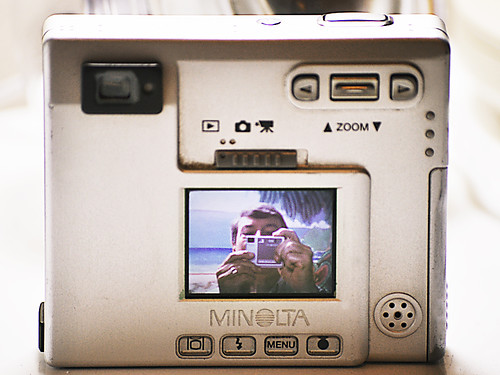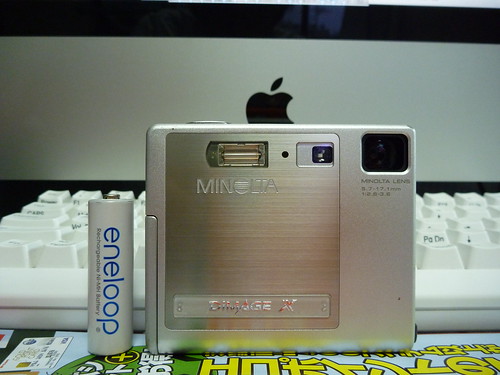Minolta DiMAGE X

|
| ocular, 1.5" screen and the control buttons image by Peter Patau (Image rights) |

|
| Minolta DiMAGE X image by datsusaramode (Image rights) |
The Minolta DiMAGE X was the original model in Minolta's series of stylish, flattened digital compact cameras. The DiMAGE X was a 2 megapixel model introduced in 2002. The camera uses a folded optics path, somewhat on the same principle as a periscope. This also avoids the startup delay for a motorized lens to extend that other compact cameras typically have. The vertically built-in periscope zoom lens is a fast 7-17.1mm/f2.8-3.6 Minolta lens. The lens is protected by a sliding door when the camera is switched off. The small color LCD on the camera back serves as second viewfinder, menu screen and image review display. The 1/2,7" CCD sensor delivers an image resolution of 1.96 megapixels at "film speeds" ISO 100 to ISO 200. Exposure is fully automatic, with shutter speeds 2sec. to 1/1000sec., and choice between light measuring variants. Astoundingly that almost ultra-compact camera includes an optical zoom viewfinder, a built-in flash, and it uses two AA-batteries as energy source. It uses SD cards as image memory.
The "X" series was continued through several more models, including the Konica Minolta DiMAGE Xg, following Minolta's merger with Konica.
Links
- Minolta DiMAGE X user manual at Manualslib
- DiMAGE X reviewed at DPReview.com
- DiMAGE X Digital Camera at Imaging Resource
- DiMAGE X at Steve's Digicams
| Japan Camera Grand Prix | |
|---|---|
| Camera of the year
1984: Nikon FA | 1985: Minolta α-7000 | 1986: Canon T90 | 1987: Canon EOS 650 | 1988: Kyocera Samurai | 1989: Nikon F4 | 1990: Canon EOS 10 | 1991: Contax RTS III | 1992: Pentax Z-1 | 1993: Canon EOS 5 | 1994: Minolta α-707si | 1995: Contax G1 | 1996: Minolta TC-1 | 1997: Nikon F5 | 1998: Pentax 645N | 1999: Minolta α-9 | 2000: Canon EOS-1V | 2001: Minolta α-7 | 2002: Canon EOS-1D | 2003: Canon EOS-1Ds | 2004: Nikon D70 | 2005: Konica Minolta α-7 Digital | 2006: Nikon D200 | 2007: Pentax K10D | 2008: Nikon D3 | 2009: Canon EOS 5D Mark II | 2010: Olympus Pen E-P1 | 2011: Pentax 645D | 2012: Nikon D800 | 2013: Sony DSC-RX1 | 2014: Nikon Df | 2015: Canon EOS 7D Mark II | 2016: Sony α7R II | 2017: Olympus OM-D E-M1 Mark II | 2018: Sony α9 | 2019: Lumix S1R | 2020: Sony α7R IV | 2021: Sony α1 | 2022: Nikon Z9 | 2023: Sony α7R V Special Prize Editor | |